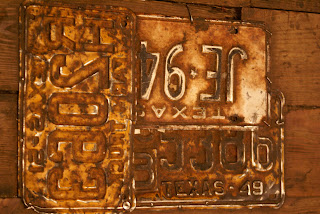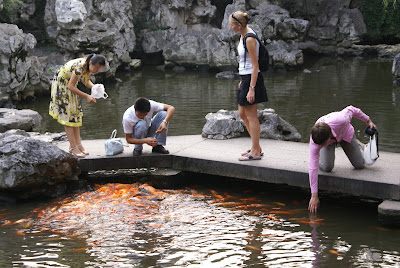If You Have Two Nights or A Week, Relax In This Small East Texas Town
| The Burlington Northern Santa Fe trains travel the rails through Jefferson at all hours and their warning whistles are part of the “flavor” of the visit. |
It had been nearly 20 years since Sheryl and I had visited Jefferson, Texas and stayed at a small bed and breakfast. At one time, during the early to mid 1800s this was one of the busiest commercial centers in Texas. It has transitioned into one of the states most well preserved communities with an abundance of bed and breakfasts, antique shops and attractions. On our first visit to Jefferson, as an amateur history buff, this part I knew. What I didn’t know when we made the reservations and what I didn’t notice when we checked in were the parallel steel rails that were literally in the back yard.
That night, after we had gone to bed but before either of us had gone to sleep we caught the faint blast of a train whistle. It barely intruded on the relaxing quietness that had enveloped the town almost as soon as the sun had set. I remembered a verse from Hank Williams’ song I’m So Lonesome I Could Cry that referred to a midnight night train whining low.
In a few moments the train whistle was repeated, only this time it was obviously much closer. Much, much closer! And again a few minutes later it was repeated! Only this time it was loud. There was nothing distant about it. Things in the house started vibrating. The ancient windows of the 19th century cottage began to rattle. And one more blast on the horn by the apparently demonic engineer nearly blew us out of the bed.
Shaken but not totally disturbed we figured we’d just file it away as another memorable bed and breakfast experience. But after we had finally gotten to sleep for the evening the previous episode repeated itself. And it repeated itself again, and again, and again. We finally lost count. We nicknamed this the “bed and breakfast from hell.”
Don’t get me wrong. All in all, the Jefferson experience was a good one. And, we’ve come back again for more. And we will probably come back again. And I recommend it.
I thought that if I’d gone this many years between visits then Jefferson would have changed. But that is one of the beauties of the place. Change happens, oh, so very slowly (if at all). Granted, the trains still come through with the determined rudeness only a train can interject into common everyday life. But this time we made our accommodations at the Chez Lafayette, a 1930s era craftsman style house close enough to walk to everything in historic downtown Jefferson and far enough from the trains to blunt the strong blasts.
The Excelsior House pre-dates the Civil War and the hotel is currently owned and operated by the Jessie Allen Wise Garden Club. |
We used a Valentine’s Day get-away as our excuse to spend 3 nights here. The Excelsior House, a hotel relic from the heady days of Jefferson’s prosperity as one of the largest cities in Texas, was hosting a Valentines Dinner and Dance. That was as good of an excuse as any to drive 4 hours from our near-Houston residence. The BYOB affair was a relaxed evening sitting at a table with 3 other very congenial couples who we had never met before. The evening was highlighted with a better than average pianist/vocalist (a former local who is apparently well know in the Dallas entertainment circles) and dancing, an impromptu demonstration in ballroom dancing by two couples from our table, and an tasty selection food.
I think I can best compare Jefferson to a diverse and extensive of a buffet of experience from dining to shopping. It has a lot to offer for a few short days at a relaxed pace. Don’t try to hurry here because it won’t do you any good. If you are used to city traffic you’ll wonder why in the world you are stopped at a red light when no traffic has come from any direction. If you expect to use a credit card at one of the popular pie specialty shops in town, you’d be wrong. And, here’s the train again, if you get caught on the wrong side of the track, there’s nothing you can do about it until the train passes.
Let’s start with dining. If you want a good ol’ East Texas style menu try out Annie Skinner’s Bar. The menu is loaded with things like chicken fried, mashed potatoes and a generous serving of fried okra. But, fair warning, smoking is allowed and the crowd gets more rambunctious as the night goes on. It was just the turn of luck that we were able to enjoy Friday’s karaoke night. There was a table of revelers, must have been about 12 of them, that had come over from Bossier City, Louisiana and had started getting tanked up on either shots of vodka or tequila. And they were here for karaoke. What a surprise I had when I discovered that these guys and gals had excellent voices and were a far cry from the amateur singers I had expected.
| Unusual wall decoration at the Jefferson Old Fashioned Hamburger Store includes walls adorned with personalized $1.00 bills. The actual treasure here are the “Best Pies in Texas.” |
On the opposite end of the spectrum (opposite at least in Jefferson) is the Stillwater Inn. This IS NOT East Texas cuisine. Tops on the menu for me was the pecan encrusted trout which rated right up there with a serving I had in Charleston, South Carolina. My wife had the pork medallions smothered in mushroom sauce. Wow! We probably could have used several more nights to work our way through the menu.
Quaint floor repairs with old State of Texas auto license plates patch holes in the floor of the Jefferson General Store. |
Or if you are after a sandwich, Jefferson is loaded with choices from hamburgers to BBQ to cold cuts. And while you are trying one of these out, see if they specialize in some sort of dessert. They probably do and you’ll be glad you asked. Oh, yea, I couldn’t pass of the novelty of buying a nickel cup of coffee at the Jefferson General Store and its not a bad place to shop for gifts and novelties. And if you look close enough you might find a license plate from your birth year patching an ancient hole in the wooden floor.
Time takes on a different meaning in Jefferson. The owner of Fred’s Books on the Bayou posted a note on the front door that he had gone to lunch. He posted his time that he left the shop at 1:45 p.m. I came by about 2:30 p.m. and figured I wait him out checking out the Liz-Beth’s Antiques next door. Here is a shop that mainly offers antique china and dinner ware, far out of my narrow collecting niche of war related artifacts. But the owner was a good conversationalist and I passed the next 30 minutes discussing an array of topics before Fred showed up a little after 3:00 p.m.
Antique shops abound. Most of the shops use the marketing ploy I like best in hunting for stuff. Shelves and tables are loaded with “junque.” Some of it is pretty good stuff. I found a 1938 University of Texas yearbook with a picture of my father, a painting of a retired rear admiral, an abundance of hand tools, china, silver and dinnerware, and a myriad of choices from entertainment to home decorating.
The Jefferson Historical Museum isn’t bad either. It houses a collection of items that has spanned hundreds of years donated by locals. From a dress worn by First Lady Lady Bird Johnson (who was raised in nearby Karnack) to artifacts from the Civil War to a fairly extensive guns and weapons section, the self-guided tour is well worth it $5.00 admission fee. The building is a retired old federal court house and post office built in the 1800s.
What else is there to do in Jefferson besides shopping, eating and musing? Plenty. There are two dinner theaters, ghost walks, ghost train rides, old west train rides, historic walking tours, riverboat tours, Caddo Lake backwater tours, and many other seasonal selections of things to do.
Antique stores abound with collectables of all types from rare to not-so-rare and prices in some stores are negotiable if you find something you really want. |
If you are going to Jefferson for the first time or have been before, I suggest that early on in your trip you stop by the Marion County Chamber of Commerce. Nearly every bed and breakfast in town as well as every attraction deposits their literature here.
If you want to plan ahead and make a reservation there are several services that let you make a reservation on line and the chamber has a list of bed & breakfast that have called them to say they have daily openings. Our hostess at the Chez Lafayette uses the Jefferson Reservation Service at www.jeffersonreservationservice.com or telephone (903) 665-3145. Another on line service is Classic Inn Reservations at www.classicinn.com or telephone 800.468.2627. There are many other reservation services from which to choose so you are not locked in to these two alone. While we were either walking or driving around town there were numerous bed and breakfasts that had posted vacancy signs.
Artifacts on display at the Jefferson Historical Museum trace the natural, Indian, and pioneer heritage of the area for centuries as well as some examples of European masters included in the Moseley Art Gallery. |
If you only have a weekend, don’t get in a hurry. Walking around is easy. I walk further in the Houston Bush Intercontinental Airport every trip than I walked to the attractions in Jefferson. If you have several days, still don’t get in a hurry. Some stores are closed during the week. One antique store I wanted to visit even had a scheduled weekly closing on Saturday.
And if it rains, as it did the long weekend we were there, may you have had the foresight to have reserved a bed and breakfast with a porch and rocker and come equipped with a good book to while away the time.Or find a deck of cards and head out to Annie Skinner’s and wait out the storms with a lively game of spades.
The Chez Lafayette Bed and Breakfast offered a broad front porch with wicker rockers that provided a respite from rain and place to relax with a book or newspaper. |
For information on what’s happening right now in Jefferson, check it out on-line with a visit the Marion County Chamber of Commerce web pages at www.jefferson-texas.com. Write for information to the Marion County Chamber of Commerce, 118 N. Vale, Jefferson, TX 75657 or telephone (903) 665-2672. Email address is jeffersonchamber@sbcglobal.net.








































